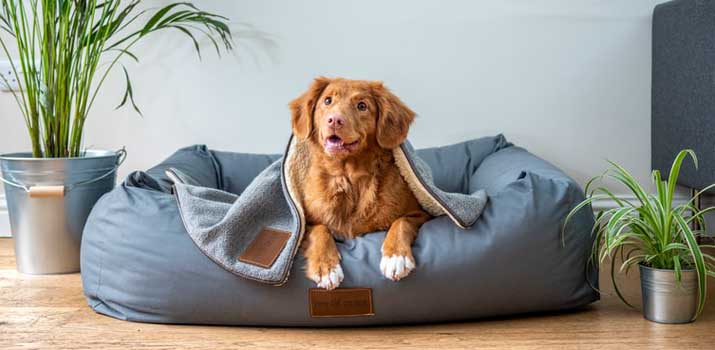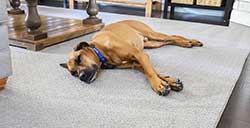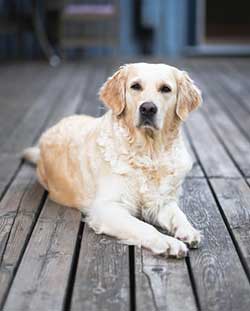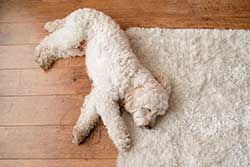
Your bed is an indispensable piece of furniture that you use daily. While most of us don't give that cozy sleeping spot a second thought, it adds tons of value to our lives. It helps up get some much-needed shut-eye, allowing us to recharge and wake up feeling ready for the day!
Its importance can't be understated. But what about dog beds?
Does your canine companion need a dedicated sleeping space to catch some Zs?

If you ever took the time to calculate how much your pup sleeps, you'd be surprised by how much of their lives they snooze away.
Collectively, canines can sleep upwards of 14 hours per day! That total time usually consists of several small naps, but it's staggering nonetheless.
Despite that information, whether or not a dog needs a bed to sleep on is still a point of contention among owners. So, what's the right choice for you and your dog?
A Matter of Personal Preference
Like many facets of your dog's life, beds are more of a luxury item than anything else. Canines are pretty adaptable and can get by without comfort items like a bed.
Wild dogs don't have access to cozy mattresses, and they manage to get plenty of sleep.
Technically speaking, dogs don't need a bed. They can survive without it just fine.
That said, it's certainly a nice thing to have around! Just take a look at how your dog sleeps without a bed.
There's a good chance that they look for the softest spot possible to lay down. Whether that's a fluffy rug or your human-sized bed, dogs will find ways to get comfortable.
If they expend the energy to climb on your sofa or sprawl out on your mattress, take it as a sign that they can benefit from having a bed of their own!
All dogs are different here. Some are more than comfortable sleeping on a hard floor. For many pups, the idea of sleeping on a bed is a foreign concept.
You're more likely to see hesitation and suspicions from dogs that spent a reasonable amount of time outside sleeping on the ground.

Meanwhile, dogs that already have access to comfortable carpeting or plush rugs might show no interest in using a bed.
Their needs are already taken care of, making the transition to using a bed unappealing.
Whatever the case may be, pay attention to your dog's behavior. How your pooch sleeps now can dictate whether a bed is necessary or not.
For most dog owners, investing in a bed is a worthy cause. Even if your dog isn't keen on taking advantage of that soft sleeping surface right off the bat, they can warm up to the idea later.
Your pup deserves the very best, and a bed is a great way to ensure that they're living in the lap of luxury.
Related: Why Do Dogs Dig at the Carpet or Scratch Their Beds?
Benefits Worth Considering
Dog beds might not be an absolute necessity, but any dog owner who uses one will tell you that they're a worthy buy. Letting your pup relax on a comfortable bed can provide several benefits that enhance their life.
Still on the fence? Here are a few significant advantages a dog bed can bring to the table.
It's Good for Their Health
Beds do more than wrap your dog in posh comfort. They can improve their health as well.
Sleep is important for canines. While you might view the 10-plus hours they sleep as overkill, it's necessary for maintaining good health.
Unfortunately, hard surfaces can make it impossible to sleep.
Without a bed, your dog could have trouble falling into a deep slumber. As a result, they'd have to rely on those short naps to recharge.
On top of that, beds can help prevent unwanted sores and chaffing. Pups that spend most of their time resting on rigid tiles or hardwood end up developing noticeable sores on their legs.
You might see them appear on the joints or pressure points that make contact with the floor.
They're pretty unsightly and can become a source of pain for your dog.
Beds help to eliminate those pressure points. They support your dog's entire body, lifting it off the ground and providing plenty of cushioning to avoid sore spots.
Also read: Why Your Dog Sleeps and Cuddles With Only You and Ignores your Husband
Beds Provide a Sense of Security
Does your dog suffer from anxiety? Do they have trouble adjusting to new surroundings?
If so, a bed could help them overcome challenging situations.
Anxiety-ridden dogs tend to resist change. They struggle the most when you pluck them out of a familiar environment and expose them to brand-new experiences.
As a result, vacations, car rides, and short trips can become a nightmare.
When you let your dog sleep on a bed, it becomes a safety net they can go to for comfort.
It's their ultimate safety zone that makes them feel secure no matter what. Use that to your advantage! Bring your pup's bed with you on extended trips, and those new surroundings suddenly become much more manageable.
A Place to Call Their Own
All dogs need a safe space to call their own.
In the early years, many owners will use kennels to establish boundaries and avoid messes. Kennels become that haven. However, things change as your reliance on containment devices lessens.
If you ever decide to stop using the kennel, your pup might lose its personal space. When this happens, your dog might end up looking for other places to claim.
That could end up being your couch, a corner in their favorite room, or even a bed in a guest room!
Giving your dog a bed of its own can eliminate some of that claiming behavior. It turns into a safe spot that they can use how they please.
You won't have to worry about your dog venturing into no-go zones or breaking the rules. It's a win-win for everyone!
A Haven for Senior Dogs

This benefit is part of the health perks we discussed earlier. But, its importance is so significant it deserves its own spot on this list!
Your dog might do fine as a puppy or adult without sleeping on a bed. However, things will change once it reaches senior status.
Older dogs and those who suffer from musculoskeletal issues will experience severe pain from sleeping on hard floors.
The pain tends to creep up the longer your dog sits. It might feel fine at first. But when they try to get up? They might end up yelping in pain!
Joint pain is no joke. Arthritis is a genuine problem that plagues millions of older dogs.
There are many ways to address joint discomfort, and providing a dog bed is one of the easiest things you can do.
Standard beds are better than nothing, but the best course of action is to provide an orthopedic mattress with memory foam and tons of joint support. More on that soon.
Keep Your Furniture Fur-Free
Here's a perk that many forget to consider.
Dealing with pet hair is just a fact of life when owning a dog. Have you ever thought about how much of it gets around your home due to your pup's sleeping habits?
When your dog is constantly searching for a spot to lay down, they're spreading fur everywhere!
Why not localize that issue to one place by providing a comfortable bed. Dog beds can minimize the spread and keep a lot of that loose fur contained.
Many models feature easy-to-clean covers and machine-washable fabrics. It makes managing fur fall out a cinch.
What Kinds of Dog Beds are Available?
There are several types of dog beds on the market today. Some are simple by design. Meanwhile, others have over-the-top features to create the ultimate sleeping oasis.
There's no right or wrong choice here. However, some designs might be better suited to your dog's lifestyle, health needs, and sleeping patterns.
Pay attention to how your pup gets some shut-eye. Whether they curl up in a ball or sprawl out can help you choose which design is best.
Pad-Style Beds
If your dog still uses their kennel as a sleeping space, bare mattresses might be an excellent solution. These beds are straightforward.
Generally, they consist of a layer of padding, a pet-proof cover, and that's it!
Many manufacturers follow sizing conventions of kennels, making it easy to find a model that fits. Of course, you don't have to use these beds in contained spaces. They work well in an open room, too.
Related: Top 5 Best Dog Crate Pads & Beds for Dogs that Chew Fabric
Bolstered Beds
Want to give your dog a good place to lay its head? Consider buying a bolstered bed. These models have a standard flat bottom, much like a simple dog mattress.
However, padded bolsters wrap around the perimeter.
Some models have only one bolster on the backside. Others use padding around all sides to give your pup options in how they sleep.
Either way, the extra cushioning acts as a pillow to keep your dog's head elevated and comfortable.
Cuddle Caves
Dogs that like to curl up in a ball as they snooze can benefit from what many refer to as a "cuddle cave."
You might see these labeled as "cocoon beds" or "cozy caves" as well.
Whatever you call them, there's no mistaking these beds for other designs. They're pretty distinct!
In addition to a heavily padded base, these beds feature a large covering. The covering could be small and tight. Alternatively, it can be open and tent-like.
Either way, the cover is almost always lined in fabric and additional padding.
That way, your pup can crawl in, curl up, and get comfortable even during the coldest nights.
Orthopedic Beds
Finally, we have orthopedic dog beds. Designed to reduce pressure on the joints, these beds are essential for seniors or dogs suffering from joint pain.
Most orthopedic beds feature multiple layers of padding. A durable base layer supports the dream-like memory foam. You might also see a layer of egg-crate foam.
Either way, the extra support reduces pressure points and prevents pain when your dog gets up.
Choosing the Right One: Factors to Think About
Take one stroll through your local pet store, and you'll quickly see that finding the perfect dog bed is no easy task! The market is flooded with options. So how can you choose?
Here are a few factors to keep in mind as you shop.
Size and Fit

Before you do a second of shopping, take some measurements. The bed you choose should be big enough to support your pup's entire body as they sleep.
The best time to take measurements is when your dog is sleeping.
Make a note of the space they utilize. Measure from the tip of the nose to the base of the tail.
Then, measure from the top of the back to the bottom of the feet.
Dogs can switch positions throughout the night, so it's better to take measurements when they sprawl out. That way, you can ensure that your bed fits no matter how they sleep.
Maintenance Requirements
As your dog's most frequently used accessory, it's only a matter of time before the bed you buy becomes a stinky mess.
We recommend getting products that are easy to clean and maintain.
Look for removable, machine-washable covers. Single-layer beds with upholstery you can't remove is a nightmare to deal with.
Make things easier on yourself and go with washable materials only. Some manufacturers even make machine-washable pads and stuffing. Don't be afraid to give those options a try.
Also read: Can Dogs Carry Bed Bugs?. Signs & Symptoms
Padding
Speaking of padding, pay attention to thickness and quality. Not all cushions are made the same.
Cheaper beds usually have loose fill. While comfortable at first, these beds quickly deflate and lose their shape. What once started as a plush sleeping surface quickly turns into a lumpy mess.
Supportive foams that don't deflate are always a good choice. Memory foam and orthopedic designs are even better.
Waterproofing
Waterproofing is a must! Bed manufacturers keep mattresses protected from moist and fluids by installing a rubber-like membrane inside.
It prevents moisture from absorbing into the padding and pooling at the bottom of the bed.
You can also find waterproof liners and accessories for even more protection.
Don't assume that you can go without waterproofing because your dog is trained. Accidents can happen. Drool and slobber can become an issue, too.
Durability
It doesn't matter how much they rely on their beds for comfort. Many rambunctious pups are bound to start chewing!
There's nothing worse than spending money on a bed and watching it deteriorate after only a few days. The best dog beds have chew-proof features to avoid that problem entirely.
They might use robust materials like canvas or heavy-duty denim.
You may see covered zippers, little piping, and reinforced stitching as well. Every detail counts when making a bed unappealing to chew-prone dogs.
Don't take this factor for granted. Otherwise, you'll end up having to buy new beds pretty frequently.
Safety
Finally, don't forget about safety.
On the bottom of the bed, look for anti-slip elements to prevent sliding. If the bed has a removable cover, make sure that it's discreet and protected by a separate fabric panel to avoid chewing.
There are many "what ifs" to consider. Keep your dog's behavior in mind, and chew beds that have features to account for the worst-case scenario.
Let Your Dog Dream Comfortably
After all that, we go back to the main question at hand: Do dogs need a bed?
Technically, they don't. There are many canines out there that can do fine without. But most dog owners will respond to that question with a resounding, "Yes, of course!"
Your dog is another member of the family that deserves all the comfort in the world.
Why not start by making their many hours of rest as cozy and rejuvenating as possible? With a good dog bed, you can.
Also Read: My Dog Pees on My Bed.. Why?

